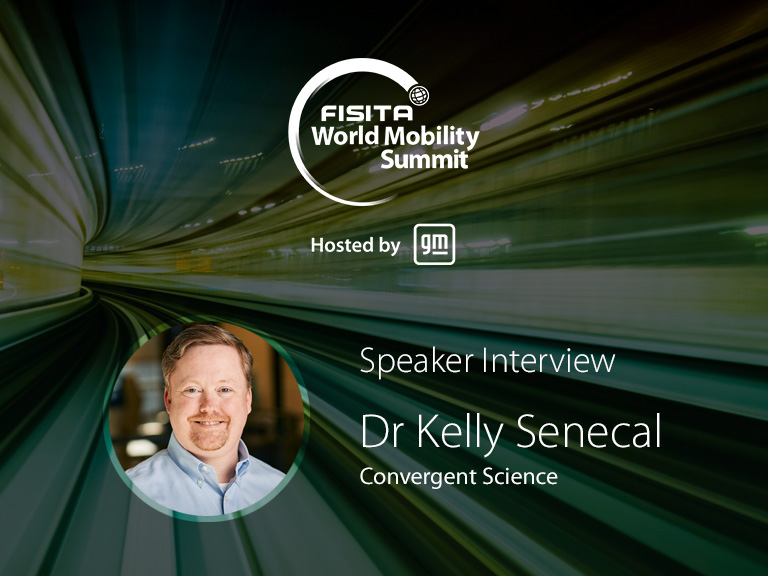
The title of the 2024 FISITA World Mobility Summit—“To EV, or not to EV?”—reflects FISITA’s technology-agnostic approach to mobility and automotive engineering, an approach that is also reflected in the event’s agenda and speaker lineup: it might be about electrification, but it’s not another EV conference.
Dr Kelly Senecal, a co-founder of computational fluid dynamics software company Convergent Science, believes the future powertrain mix will be diverse rather than exclusively electric, with automotive engineers continuing to find efficiencies in internal combustion engine (ICE) technology using alternative fuels.
Kelly is one of the panellists in the discussion on the 20-year outlook for propulsion technology. “The quest for cleaner mobility and perceived ‘bumps in the road’” will see Kelly joined onstage by Lisa Drake, Vice President, EV Programs and Energy Supply Chain at Ford Motor Company; John McElroy, President, Blue Sky Productions and host of Autoline After Hours; and Lynda Tran, CEO, Lincoln Room Strategies.
Kelly has long been an advocate of creating cleaner propulsion systems, with a particular focus on using CFD and HPC to enable faster design, and will keenly share his thoughts on combustion engines, electric motors, and the future powertrain mix.
In the build-up to the 2024 FISITA World Mobility Summit, we spoke to Kelly and asked him to share some thoughts on the event’s topic, “To EV, or not to EV?”.
What are the key challenges for the automotive industry in the transition to clean mobility, and how could these be overcome?
If clean mobility is the ultimate goal, there are two key questions we need to ask ourselves. First, what do we mean by “clean”? And second, “Clean for whom?” The supply chain for producing, using, and disposing of mobility technologies affects many individuals and ecosystems—not just the residents of city centres who are concerned about tailpipe emissions.
Following this, a significant challenge lies in balancing tailpipe-only regulations with customer preferences. We’re discovering that many customers do not—at least not yet—prefer the options being promoted by automakers, who face the difficult task of satisfying both regulatory demands and customer expectations.
Sales of battery electric vehicles (BEVs) are slower than initially hoped and expected, but the products themselves are highly compelling. What has impressed you most about the evolution of BEVs?
Battery electric vehicles are a great technology. They’re fun to drive, can be charged at home—at least, if you’re fortunate enough to have a place to do so—and can be the cleanest option available. If I had to pick one thing that has impressed me the most, it’s how quickly the cost of lithium-ion batteries has fallen over the past ten years.
We’re seeing regional and national governments introduce restrictions or bans on the sales of ICE vehicles after certain dates. Where do you stand on the regulatory push versus market pull?
I strongly believe that technology bans are never the right solution. Such bans will almost certainly change and may even be cancelled. However, they leave companies with reduced capacity to continue improving technology, in this case ICEs, resulting in the future use of sub-optimal ICEs, and that doesn’t help anyone.
Electrification appears to be inevitable, but few automakers can compete by producing BEV only, and BEV is not suitable for all markets, in terms of cost, infrastructure, and terrain. How will the transition play out?
I can’t predict the future, but I can suggest a potential approach. In the US, it seems prudent to use life cycle assessment (LCA) alongside other factors, such as cost, to determine which technologies should be prioritised in each state. The most effective options will likely be BEVs or hybrids, and it’s important to prioritise building up charging infrastructure in states where the data supports it. In other states, full hybrids offer a significant reduction in greenhouse gases without requiring changes in consumer behaviour. This diverse, rather than exclusively electric, strategy may be the quickest path to achieving transportation decarbonisation in the near future.
Despite the seemingly inevitable transition to electrification, engineers are still making notable developments in ICE technology. If you expect an eclectic rather than exclusively electric strategy, how do you see the powertrain mix evolving?
Regarding ICE technology, my key message is: “It’s not the engine—it’s the fuel!” While we must reduce our reliance on fossil fuels, this doesn’t necessarily mean we should abandon a proven technology. Instead, we should focus on advancing ICE technology so it can operate efficiently with a range of alternative fuels.
You’re speaking at the FISITA World Mobility Summit in November 2024. The event is titled, ‘To EV, or not to EV?’ With that in mind, what will be your key message to delegates?
My key message is that the answer to the titular question is a resounding, “It depends!” EVs can be a great option, but they are not always the best option. In fact, the real question may be: “What is the best powertrain solution for a given application and location?”
The Summit is a must-attend event for global mobility leaders, offering a dynamic platform for high-level discussions, collaboration, and debate. It’s a key event within the global mobility community, driving thought leadership and fostering engagement in FISITA’s member-led environment. Don’t miss the panel featuring Kelly Senecal, Lisa Drake (Ford), John McElroy (Blue Sky Productions), and Lynda Tran (Lincoln Room Strategies), as they tackle the future of cleaner mobility and the challenges and opportunities in the industry’s shift to sustainability.